Auburn’s Pioneer Cemetery has been the scene of odd goings-on this week.
Human forms, pushing a wheeled implement over the grass, back and forth, back and forth, heads bent, as if they would seek out and converse with the dead.
But any greeting from the turf, however well meant, and Penhall Technologies‘ tech folk, Mariah Otterson and A.J. Land, would probably chuck the ground-penetrating radar and skedaddle.
See, they’re not there to yammer with the great beyond; they’re there to find out who’s under the grass, and who isn’t.
That is, the City of Auburn and the White River Valley Museum recently hired Penhall, a nationally known company more often employed for finding underground pipes and wiring, to inventory the entire cemetery.
Cemetery Director Craig Hudson said he still hears from people who want to be buried or inurned in the old cemetery or to have loved ones placed there.
Here’s the catch: the cemetery is full up – officially speaking.
“Auburn would like to continue using the cemetery, but at this point, we feel it’s full,” said WRVM Director Patricia Cosgrove. “However, we also bet that it actually isn’t. The first step is to do this research on the ground with radar, which can tell us where ground disturbances have been, and at what depth.”
Later the City plans to restore some of the missing statuary or headstones.
Radar work began at 7:30 a.m. Monday and was to have taken three to four days. Otterson said the findings will be analyzed in the coming weeks.
For any such undertaking, of course, there must also be a researcher willing to pore over old records. In this case, that person is Hillary Pittenger, the museum’s curator of collections and a fount of information about the cemetery’s history.
“When the town of Auburn built Mountain View Cemetery, about 1912, the valley was still prone to annual flooding. For this reason, relatives of many of the Caucasian people who were buried there moved their remains up to the new cemetery. Most of the graves left at Pioneer were Japanese members of the White River Buddhist temple,” Pittenger said.
For decades, Frank Natsuhara and his grandson, Charles, members of the temple, tended the cemetery. Even today, the tie between the Buddhist congregation and the cemetery is strong.
Still, bringing the project to completion is going to take some doing.
For one thing, Cosgrove said, the immigrant Japanese often installed monuments that look like grave markers but there is nobody buried under them. And there may be graves that are actually interment sites for ashes.
Then, too, Cosgrove said, records aren’t exactly spot on about how many Caucasian people were moved to Mountain View and how many still lie in the old cemetery.
Finally, many of the markers are written in Kanji, Japanese characters, and some are badly worn by time and the elements.
Here’s how this project got started.
First, 4Culture of King County awarded WRVM a grant to write a landmark nomination for the cemetery. If that is successful – the City will know in a few months – it will allow the City to apply for more grants.
Next came a surprise – an unsolicited $20,000 grant from King County to cover the research and preservation work.
“There’s enough money in this grant to begin restoration and to replace some of the missing statuary or headstones,” Cosgrove said.
Greg Watson of Auburn has always taken a keen interest in the cemetery. Having earned his masters in museum studies at the University of Washington, he teaches art, state and world history today at West Auburn High School.
“I have friends in the Japanese community in Seattle say that everybody in the Puget Sound area has some connection to that cemetery. People who go to the Tacoma Buddhist Temple, people who go to Seattle, everybody has some kind of connection because it’s kind of a unique thing,” Watson said. “On Memorial Day, families would come and grandparents who might be second generation bring their grandkids, so there’d be these teenagers, college students and kids who would bow their heads over the headstones. Their heritage is really about tremendous respect.”



